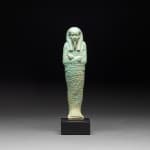Egyptian Faience Ushabti, 664 BCE - 525 CE
Faience
height 18.4 cm
height 7 1/4 in
height 7 1/4 in
PF.5797
Further images
Perhaps no single object epitomizes the spirit of Ancient Egypt better than the ushabti. Shaped like a divine mummy, the ushabti evokes the magical side of the Egyptian belief in...
Perhaps no single object epitomizes the spirit of Ancient Egypt better than the ushabti. Shaped like a divine mummy, the ushabti evokes the magical side of the Egyptian belief in an afterlife, while the two hoes clutched in the hands recall the rural, agrarian culture of the land. The word ushabti (supplanting the older term shawabti) literally means “the answerer.” The function of these little figures is described in Chapter VI of the Book of the Dead: “O this Ushabti! If (the deceased) is called upon to do hard labor in the hereafter, say thou: I am here.” The ushabti was expected to answer the call to work in place of the deceased, and this passage was frequently inscribed on the figures themselves. Originally, a single ushabti was placed in a given tomb; but by the New Kingdom, the statues had come to be regarded as servants and slaves for the deceased rather than as a substitute, and many might be found buried together, along with an overseer figure. In the course of Egyptian history, ushabti were created from wood, stone, metal, and faience. In the cultural renaissance of the XXVI Dynasty (Saite period), a green faience, the color of the Nile and evocative of the verdant landscape in springtime, was particularly popular. To look upon an ushabti is to come face to face with the mystery and magic of Egypt itself.











